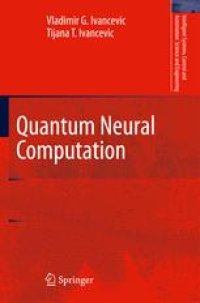
Ebook: Quantum Neural Computation
- Tags: Artificial Intelligence (incl. Robotics), Appl.Mathematics/Computational Methods of Engineering, Quantum Physics, Quantum Information Technology Spintronics, Neurobiology
- Series: Intelligent Systems Control and Automation: Science and Engineering 40
- Year: 2010
- Publisher: Springer Netherlands
- Edition: 1
- Language: English
- pdf
Quantum Neural Computation is a graduate-level monographic textbook. It presents a comprehensive introduction, both non-technical and technical, into modern quantum neural computation. Classical computing systems perform classical computations (i.e., Boolean operations, such as AND, OR, NOT gates) using devices that can be described classically (e.g., MOSFETs). On the other hand, quantum computing systems perform classical computations using quantum devices (quantum dots), that is, devices that can be described only using quantum mechanics. Any information transfer between such computing systems involves a state measurement.
This book describes this information transfer at the edge of classical and quantum chaos and turbulence, where mysterious quantum-mechanical linearity meets the brain's even more mysterious nonlinear complexity, in order to perform super–high–speed and error–free computations. This volume describes a crossroad between quantum field theory, brain science and computational intelligence.
Quantum Neural Computation is a graduate-level monographic textbook. It presents a comprehensive introduction, both non-technical and technical, into modern quantum neural computation. Classical computing systems perform classical computations (i.e., Boolean operations, such as AND, OR, NOT gates) using devices that can be described classically (e.g., MOSFETs). On the other hand, quantum computing systems perform classical computations using quantum devices (quantum dots), that is, devices that can be described only using quantum mechanics. Any information transfer between such computing systems involves a state measurement.
This book describes this information transfer at the edge of classical and quantum chaos and turbulence, where mysterious quantum-mechanical linearity meets the brain's even more mysterious nonlinear complexity, in order to perform super–high–speed and error–free computations. This volume describes a crossroad between quantum field theory, brain science and computational intelligence.
Quantum Neural Computation is a graduate-level monographic textbook. It presents a comprehensive introduction, both non-technical and technical, into modern quantum neural computation. Classical computing systems perform classical computations (i.e., Boolean operations, such as AND, OR, NOT gates) using devices that can be described classically (e.g., MOSFETs). On the other hand, quantum computing systems perform classical computations using quantum devices (quantum dots), that is, devices that can be described only using quantum mechanics. Any information transfer between such computing systems involves a state measurement.
This book describes this information transfer at the edge of classical and quantum chaos and turbulence, where mysterious quantum-mechanical linearity meets the brain's even more mysterious nonlinear complexity, in order to perform super–high–speed and error–free computations. This volume describes a crossroad between quantum field theory, brain science and computational intelligence.
Content:
Front Matter....Pages I-XV
Introduction....Pages 1-41
Brain and Classical Neural Networks....Pages 43-150
Quantum Theory Basics....Pages 151-217
Spatio-Temporal Chaos, Solitons and NLS....Pages 219-347
Quantum Brain and Cognition....Pages 349-435
Quantum Information, Games and Computation....Pages 437-558
Appendix: Mathematical and Computational Tools....Pages 559-839
Back Matter....Pages 841-929
Quantum Neural Computation is a graduate-level monographic textbook. It presents a comprehensive introduction, both non-technical and technical, into modern quantum neural computation. Classical computing systems perform classical computations (i.e., Boolean operations, such as AND, OR, NOT gates) using devices that can be described classically (e.g., MOSFETs). On the other hand, quantum computing systems perform classical computations using quantum devices (quantum dots), that is, devices that can be described only using quantum mechanics. Any information transfer between such computing systems involves a state measurement.
This book describes this information transfer at the edge of classical and quantum chaos and turbulence, where mysterious quantum-mechanical linearity meets the brain's even more mysterious nonlinear complexity, in order to perform super–high–speed and error–free computations. This volume describes a crossroad between quantum field theory, brain science and computational intelligence.
Content:
Front Matter....Pages I-XV
Introduction....Pages 1-41
Brain and Classical Neural Networks....Pages 43-150
Quantum Theory Basics....Pages 151-217
Spatio-Temporal Chaos, Solitons and NLS....Pages 219-347
Quantum Brain and Cognition....Pages 349-435
Quantum Information, Games and Computation....Pages 437-558
Appendix: Mathematical and Computational Tools....Pages 559-839
Back Matter....Pages 841-929
....